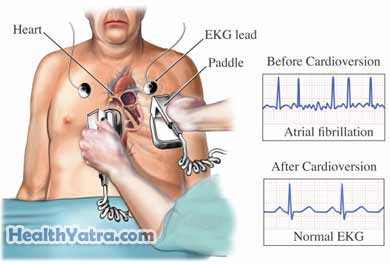تعريف
Cardioversion is the delivery of an electric shock to the chest through electrodes or paddles. The shock is given to correct a dangerous heart rhythm.
Cardioversion can be done as an elective (scheduled) procedure or may be done urgently if an abnormal heartbeat is immediately life-threatening.

أسباب هذا الإجراء
If the heart is not beating regularly, it may prevent the normal circulation of blood through the body. This may deprive various organs, including the brain and heart, of oxygen. Without oxygen, the organs cannot properly function and will eventually die.
In atrial fibrillation, the electrical signals from the atria are fast and irregular. The atria quiver, rather than contract. Some signals do not reach the ventricles and the ventricles continue pumping, usually irregularly and sometimes rapidly
Non-emergency cardioversion may be used to treat the following conditions:
- Atrial fibrillation —very rapid, irregular quivering in the atrium; ventricles pump irregularly
- Atrial flutter —rapid but regular contractions in the atrium, when the ventricular heart rate is not too fast
Emergency cardioversion may be used to treat the following types of irregular heartbeats, which can lead to death if they are not immediately converted to a more normal rhythm:
- Atrial tachycardia —rapid beating of the heart, originating in the atrium with rapid ventricular heart rate
- Ventricular tachycardia—rapid beating of the heart, originating in the ventricle
- Ventricular fibrillation —rapid movement of the ventricular muscle without effective pumping (may be a fatal)
المضاعفات المحتملة
If you are planning to have cardioversion, your سيقوم الطبيب بمراجعة القائمة من المضاعفات المحتملة، والتي قد تشمل:
- Inability to stop the abnormal rhythm
- Abnormal rhythm is resumed after a normal rhythm was established
- Development of a more dangerous dysrhythmia
- Damage to the heart muscle
- Blood clots introduced into your circulation, leading to such complications asstroke or damage to your organs
- Burning or irritation to the skin of the chest where the paddles or electrodes are applied
ما يمكن توقعه
قبل الإجراء
For elective cardioversion:
- To diagnose the condition, you will have an electrocardiogram (ECG, EKG). An EKG can record the heart’s electrical activity.
- You may be given blood thinners for several weeks before the procedure.
- You may undergo a transesophageal echocardiogram. This is an ultrasound test to look for blood clots in the heart.
- للترتيب من الإجراء.
- رتبي للحصول على المساعدة في المنزل بعد العملية.
- في الليلة السابقة، تناول وجبة خفيفة. لا تأكل أو تشرب أي شيء بعد منتصف الليل.
- Check with your doctor to see if you should take your medicines normally on the morning of the procedure.
For urgent cardioversion, there is no time for to prepare for the procedure.
التخدير
You will have a short-acting deep sedation, so you will be unaware of the procedure happening.
وصف الإجراء
Electrodes or paddles will be applied to the chest. An electric charge will be delivered through these electrodes or paddles to the chest and into the heart. This resynchronizes the electrical activity of the heart. It allows the heart’s normal pacemaker to resume normal function. The process may need to be repeated. The electric charge may be increased with each attempt.
مباشرة بعد الإجراء
You will be monitored closely in a recovery room until you are fully awake. You may be allowed to go home after the procedure. If a medicine needs to be started to keep your heart in rhythm, you may need to stay in the hospital.
كم من الوقت سيستغرق ؟
The procedure itself is usually less than 30 minutes.
كم هو مؤلم ؟
Sedation prevents pain during the procedure. If you have an urgent cardioversion, you may be partially aware during the procedure. You may feel a jolt that some people liken to a kick in the chest.
متوسط الإقامة في المستشفى
If you had non-emergency cardioversion, you may be sent home once you are in stable condition.
People who need emergency cardioversion may be admitted to the hospital. This may be done for further observation or because of the underlying illness that caused the event.
رعاية ما بعد العملية
في البيت
Be sure to follow your doctor’s instructions . You may be put on blood thinners for a few weeks after the procedure. In this case, blood levels of these medicines will need to be monitored via blood tests, usually weekly. You may also be put on a medicine called an anti-arrhythmic. This type of drug will help prevent the abnormal heartbeat from happening again.
استدعاء الطبيب
بعد مغادرة المستشفى، اتصل بطبيبك في حالة حدوث أي مما يلي:
- Blisters, redness, or open sores on your chest
- Confusion, lightheadedness, or dizziness
- الإحساس بقلبك يرفرف (الخفقان)
- Sensation of a skipped or missed heartbeat, or an irregular pulse
- Cough, difficulty breathing, shortness of breath
- الغثيان أو القيء الشديد
- Chest pain or pain in your left arm or jaw
- Pain in your abdomen, back, arms, or legs
- دم في البول
- Changes in vision or speech
- Difficulty walking or using your limbs
- Drooping facial muscles
في حالة الطوارئ ، اتصل على المساعدة الطبية على الفور.
